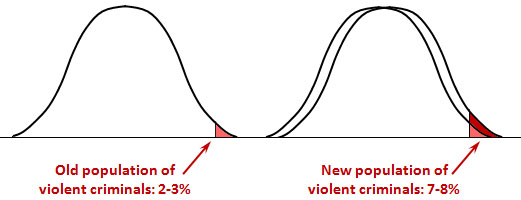One of my Twitter followers, @archeratlarge, asks:
Has anyone applied @kdrum’s analysis of lead and crime to education outcomes?
I get asked this a lot, and it’s a slow news day, so I’m going to semi-answer this. As it happens, a little bit of work has been done on this question, but not much. And there’s a pretty good reason for that.
At first glance, this seems like an obvious thing to look at. The jury may still be out on the connection between lead and crime, but it’s certainly not on lead’s general effect on developing brains. There’s overwhelming, and universally accepted evidence that exposing children to high lead levels reduces their IQs and contributes to learning disabilities. So reducing exposure to lead, as we did by introducing unleaded gasoline between 1975 and 1995, certainly ought to show up in school test scores, graduation rates, and so forth.
But there’s an analytic problem that makes it hard to measure this. Let’s take a look at crime first. Very few people are potential violent criminals. If you plot criminal tendencies on a bell curve, perhaps the rightmost 3 percent or so are likely to actually commit murder, rape, or assault.
But when you expose huge numbers of children to lead, as we did with leaded gasoline after World War II, what you’re essentially doing is moving the bell curve to the right. For most people, that makes very little difference. But for a few who were already on the edge, it pushes them over into a life of violent crime. And when you move a bell curve, the area under the rightward tail increases a lot. The diagram below illustrates this:

What this means is that a small effect from lead can have a very big effect on the level of violent crime. Crime rates will double or triple, and this makes it amenable to statistical study. Because crime has so many different causes, it’s still not easy to figure out what happened, but at least it’s possible.
Education is exactly the opposite. In this case, we’re dealing with big groups (nearly everyone graduates from high school) or averages (test scores, for example). Those move only slightly when the bell curve moves to the right:

You can see the problem. If, say, the average score on a test improves from 300 to 307 over the course of 20 years, it’s too small an effect to isolate. The same is true if graduation rates increase from 75 percent to 79 percent. There are dozens of things that could plausibly cause this, and figuring out a way tease out the individual contribution of lead is all but impossible.
The decline of leaded gasoline almost certainly had an effect on educational outcomes. I’d guess that essentially no one doubts this. But because you’re studying an entire student population, not just a tiny fraction at the right end of a bell curve, the effect is too small to study. It’s probably there, but we’re unlikely to ever put a number to it.














